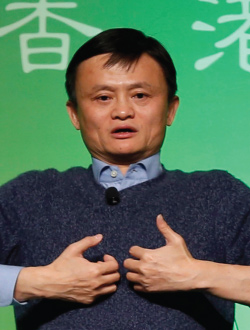Will Chinese Companies Displace US Ones?

 Not so fast. All will turn on culture and rules
Not so fast. All will turn on culture and rules
For the first time ever in the Forbes magazine ranking of the largest global public companies, China was home to the three biggest companies in 2014 (Industrial and Commercial Bank of China, China Construction Bank, and Agricultural Bank of China). Indeed, Chinese companies comprised five of the top 10 spots on the Forbes list. Still, American companies continued to dominate the list of the world’s most valuable public companies, occupying nine of the top 10 spots, with Apple, Exxon Mobil, Google, Microsoft and Berkshire Hathaway leading the way.
Should we bet on US companies continuing to dominate the list of the most valuable companies in the world over the next 10 to 15 years? Or should we bet on Chinese companies – or perhaps Indian companies, even if the most valuable Indian company, Tata Consultancy, ranked only 121st in market value in 2014? Let me make the argument for continuing American dominance.
According to Forbes, there were 564 US companies (28 percent) among the largest 2,000 public companies. Of these 2,000, there were 207 Chinese (including Hong Kong-based) companies (10 percent); 225 Japanese companies (11 percent); and 54 Indian companies (three percent). When compared with each country’s share of global GDP in 2013, the US and Japan were overrepresented among the top 2,000 companies, while China was underrepresented. India was more or less ‘fairly’ represented. If China continues to grow more rapidly than the US and Japan, it is conceivable that by 2030, China may have the most companies on Forbes list, followed by the US and the EU, with Japan – which will likely grow far more slowly than China – trailing further behind.
On the other hand, if we focus on only the 300 most valuable companies on the Forbes list, the picture is much different. There were 121 US companies (40 percent) among these 300 companies, with only 21 Chinese companies (seven percent), 15 Japanese companies (five percent), and just one Indian company. Of course, 50 years ago there would have been no Chinese companies at all on the list, and likely no Indian or Japanese companies either. To be sure, at least 53 US companies would themselves have not been on the Forbes list, as many of them had not yet been created by the mid-1960s.
It goes without saying that corporate leaders will continuously change over time. If we were to compare the companies on the Fortune 500 list in 1970 with those on the list in 2014, we would find that there had been dramatic turnover. And beyond these lists, consider the following short list of companies that were once dominant or significant players in their industries, and now are no longer so: Kodak, Xerox, Polaroid, Zenith, Sears, TWA, Washington Mutual, Barnes & Noble, HMV, Pan Am, People Express, General Motors, Bethlehem Steel, Worldcom, Dynegy, Bear Stearns, Commodore Computers, Nokia, RCA, Netscape, Texaco, Lehman Brothers, Global Crossing, Eastern Airlines, Adelphia Communications, Blockbuster, Merrill Lynch, Nortel, Arthur Andersen, Enron, Wang Labs, Barings Bank, and Daewoo.
Recall that during the 40 years following WW2, like today’s China, Japan also experienced very high rates of growth. By the mid-1980s, Japan’s fast-growing companies had become dominant in many industries, including banking, consumer electronics, machinery and industrial equipment, and eventually autos. It was not uncommon to hear policy-makers in the West argue that the West should follow the lead of Japan. And yet today, while Japanese companies continue to lead in the motor vehicle and industrial equipment and robotics industries, they have fallen behind in financial services (the largest banks in the world were once Japanese banks), consumer electronics (Sony, Panasonic, Sharp and Toshiba are still around, but are already far from being market leaders), and computer hardware.
Can China and Chinese companies avoid the pitfalls of Japan, where high rates of growth have been replaced by almost 25 years of stagnation? The Chinese market is certainly far larger, and there appears to be stronger government support for the leading companies in China. Will Chinese companies be able to succeed beyond their borders? Will they be able to succeed if and when their internal markets become more open?
It is easier for companies to grow through imitation. It is difficult to grow when a company is at the technology frontier. Said Joseph Schumpeter: “This process of Creative Destruction is the essential fact about capitalism.” He also said: “[T]he function of entrepreneurs is to reform or revolutionize the pattern of production by exploiting an invention or, more generally, an untried technological possibility for producing a new commodity or producing an old one in a new way […].”
For his part, Harvard Business School’s Michael Porter argued, many years after Schumpeter, that companies must continuously develop strategies to produce a competitive advantage. Success in creating a competitive advantage is what sets apart the dominant companies from their mediocre competitors. And success inevitably depends upon the skills and talent of senior management; the execution of the strategies; good corporate governance; and, to be sure, luck. Moreover, successful companies can never afford to stand still and rest on their laurels. As Schumpeter noted, there will always be someone trying to displace them.
Returning to the Forbes list, if we look at the distribution of companies across sectors, China’s corporate presence becomes less impressive. There are few Chinese companies among the largest in the following sectors: biotech, computer hardware, computer services, consumer electronics, electronics, medical equipment and supplies, pharmaceuticals, software, telecom services, aerospace, business and personal services, communications equipment, and healthcare services. On the other hand, US companies appear in almost every sector.
US companies look even more promising when we look at the lists of the most innovative companies and companies with the highest brand value. On the Thomson Reuters 2014 list of the “Top 100 Global Innovators,” there are 35 US companies, 39 Japanese companies, only one Chinese company, and no Indian companies. The fact that 25 of the US companies had market values in excess of US$20 billion, while only 11 of the Japanese companies had reached this level, puts to rest any presumption of any Japanese corporate renaissance.
American dominance is even more apparent on the Forbes 2014 list of the 100 “Most Innovative Companies.” There are 37 US companies on this list – this in contrast with only eight Chinese companies, seven Japanese companies, and four Indian companies. Other than Baidu and Tencent (both software and services), the Chinese companies on the list do not show up in the highly innovative industries with significant growth opportunities: consider Henan Shuanghui Investment (meat processing); Tingyi Holding (production and distribution of instant foods); Hengan International Group (personal hygiene products); Li & Fung (consumer goods sourcing and logistics); Dairy Farm International (supermarkets, hypermarkets, health and beauty, convenience and home furnishings stores); and Inner Mongolia Yili (dairy products).
Nor does the Forbes “Asia Fab 50 Companies” list suggest that China enjoys any massive lead on India in terms of future successes: there are 19 Chinese companies on this list, as compared with 10 Indian companies.
Finally, Brandirectory’s 2014 list of the “World’s Most Valuable Brands” includes 44 US companies. Indeed, US companies occupied nine of the top 10 spots. There were 10 Chinese companies on the list, with the highest ranking company being China Mobile at 13. Half of the Chinese companies on the list were in financial services. There were 11 Japanese companies and only one Indian company on the list.
Innovation and brand reputation are key drivers of a company’s future success. Evidently, there is no assurance that a high ranking today will ensure continued success in the future, as there have been many examples of companies that have stumbled. But the US companies appear to be better situated for future success, and even if the current leaders are not necessarily tomorrow’s leaders, given the track record of US companies, they are likely to continue to dominate across a wide range of industries.
Of course, at the end of the day, corporate success will be driven by culture as reflected in creativity and entrepreneurship – especially the ability to admit mistakes and accept failure – as well as rules, including ones creating strong governance practices and encouraging openness. High levels of education alone do not ensure success. People must be willing to take chances and start anew when they fail. Capital markets cannot shun past failures.
Governments evidently play important roles in establishing the rules of the game for the functioning of markets. In other words, markets do not exist in a vacuum: they are circumscribed by rules and historical relationships. Most countries have a similar range of laws and rules. However, the interpretations and objectives do differ across countries. So too does the enforcement of the rules. There are also differences across countries in the acceptance of the rules by the people. The more confidence that people have in the rule of law and the objectivity and independence of the courts, the more inclined they will be to honour the rules. It follows that people’s behaviour in markets will differ across countries as a result of differences in rules, the enforcement of the rules, the confidence that people have in the legitimacy and objectivity of government, and indeed their experiences in their markets. From a company strategy point of view, then, what might work in one geographic market might not work in another.
To date, it appears that China’s system of rules has been more successful than that of India in promoting national economic growth and the concomitant growth of domestic companies. Moreover, Chinese rules also seem to have been more successful than the rules in the US in spurring economic growth.
Japan fell behind because of the inability of government and business leaders to accept and admit failure. Corporate conglomerates carrying the names of their founders were treated as family fiefdoms, stifling, in many cases, criticism and alternative views.
Can China become a more open society? If so, Chinese companies should continue to succeed. Will they achieve more success than their US counterparts? Not likely over the next 15 years because of the significant gaps that they need to overcome. Can the leadership of China give up their reins and begin to tolerate dissent? Top-down central planning – even highly competent planning – will get a country only so far. Such countries can catch up, but there are no examples where such countries have forged ahead, consistently pushing the technological frontier forward in the process.
Fred Lazar is Associate Professor of Economics at the Schulich School of Business, York University (Toronto).



